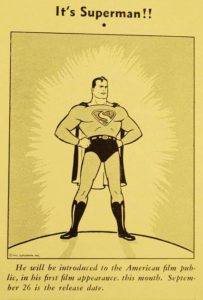 By the time period of the article below, the temporary craze of realistic animation provided by the Fleischer Superman series was on the wane. Budgetary constraints were no doubt a factor in the demise of the series at the hands of Famous Studios. But possibly equally so was an increasing lack of inspiration from the writing staff in coming up with new situations for the stranger from Krypton to battle. Numerous of the late installments in the run had settled upon WWII enemies as easy prey for the war effort. Only a handful offered original story concepts without wartime themes. Thus, as war enemies were vanquished or placed on the run, the Famous boys simply ran out of ideas. Oddly, there was never an episode in which Superman found his “Kryptonite” – not any recurring supervillain like Luthor created to provide a regular foe. Perhaps the writers might have done better sharing resources or following more closely the story lines of the parallel comics or radio shows. But acting independently, the storylines apparently were not of sufficient originality to merit the comparatively massive budgets normally allotted for Superman episodes, and the front office executives would finally pull the plug on the whole affair. While a few Popeyes (such as Rocket to Mars would contain dramatic moments and heightened effects, looking like the animators were trying to cram Superman-style ideas into normal budgets at one-third the price, there would be no follow-up in studio history to the concept of realistic dramatic human animation, and production would return to “strictly toony”. Oddly also, no other studio (excepting moments in the feature work of Disney) would follow suit in attempting any projects even resembling the Superman product. The return of dramatic superhero animation would have to wait until the 1960’s with the revival of the Superman series by Filmation, and Hanna-Barbera’s breakthrough experiment with Johnny Quest and its own subsequent rash of new super-heroes. Elsewhere, the birth of Anime in Japan would also provide new lifeblood for realistic and dramatic storytelling.
By the time period of the article below, the temporary craze of realistic animation provided by the Fleischer Superman series was on the wane. Budgetary constraints were no doubt a factor in the demise of the series at the hands of Famous Studios. But possibly equally so was an increasing lack of inspiration from the writing staff in coming up with new situations for the stranger from Krypton to battle. Numerous of the late installments in the run had settled upon WWII enemies as easy prey for the war effort. Only a handful offered original story concepts without wartime themes. Thus, as war enemies were vanquished or placed on the run, the Famous boys simply ran out of ideas. Oddly, there was never an episode in which Superman found his “Kryptonite” – not any recurring supervillain like Luthor created to provide a regular foe. Perhaps the writers might have done better sharing resources or following more closely the story lines of the parallel comics or radio shows. But acting independently, the storylines apparently were not of sufficient originality to merit the comparatively massive budgets normally allotted for Superman episodes, and the front office executives would finally pull the plug on the whole affair. While a few Popeyes (such as Rocket to Mars would contain dramatic moments and heightened effects, looking like the animators were trying to cram Superman-style ideas into normal budgets at one-third the price, there would be no follow-up in studio history to the concept of realistic dramatic human animation, and production would return to “strictly toony”. Oddly also, no other studio (excepting moments in the feature work of Disney) would follow suit in attempting any projects even resembling the Superman product. The return of dramatic superhero animation would have to wait until the 1960’s with the revival of the Superman series by Filmation, and Hanna-Barbera’s breakthrough experiment with Johnny Quest and its own subsequent rash of new super-heroes. Elsewhere, the birth of Anime in Japan would also provide new lifeblood for realistic and dramatic storytelling.
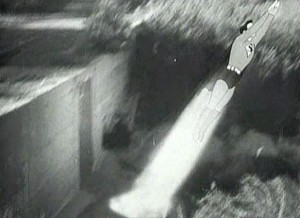 However, the impact of the man of steel did not remain forgotten to Hollywood’s traditional animators, nor the fact that the character remained popular in print, on radio, and now even on the silver screen in live-action form, in a pair of theatrical serials licensed to Columbia Pictures – some of the oddest serial footage to ever emerge from a major studio. Instead of flying effects (as had been pulled off to competent success in live action in rival Republic Pictures’ adaptation to the serial screen of Adventures of Captain Marvel, every time Superman needs to fly or perform an expensive feat of strength, Columbia dissolves him from live action into a cartoon! The effect is no Roger Rabbit Toontown wonder, and is absolutely jarring and both horrible and laughable at the same time.
However, the impact of the man of steel did not remain forgotten to Hollywood’s traditional animators, nor the fact that the character remained popular in print, on radio, and now even on the silver screen in live-action form, in a pair of theatrical serials licensed to Columbia Pictures – some of the oddest serial footage to ever emerge from a major studio. Instead of flying effects (as had been pulled off to competent success in live action in rival Republic Pictures’ adaptation to the serial screen of Adventures of Captain Marvel, every time Superman needs to fly or perform an expensive feat of strength, Columbia dissolves him from live action into a cartoon! The effect is no Roger Rabbit Toontown wonder, and is absolutely jarring and both horrible and laughable at the same time.
Nevertheless, the serials were considered commercially successful. The same studio would also bring Batman and Robin to the screen in a pair of serials (thankfully without animation), which, although depriving the Bat of any ot the dark character traits or internal angst, were at least well-enough remembered to be regionally revived for screenings in the 1960’s, and attended by a certain William Dozier, who saw inspiration for a bi-weekly television series – and the rest is history. Thus, the legacy of the superhero remained alive enough during the remainder of animation’s golden era to continue to receive occasional lampoon, providing the stars listed below with more opportunities to don tights, masks, cowls or capes, and flex their muscles for the public.
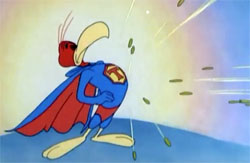 Jerky Turkey (MGM. 4/7/45, Tex Avery, dir.) – In this Thanksgiving romp, previously reviewed in my series, “How Grim Was My Pilgrim”, who else but Avery would interrupt a standard chase scene of Pilgrim vs. Turkey to have the bird suddenly stop running in mid-chase, turn to face the Pilgrim against a sunburst-lighted backdrop, and transform in a split second into a full-blown Superman outfit, complete with “T” insignia on his shirt, to have the Pilgrim’s bullets incongruously bounce off his chest?
Jerky Turkey (MGM. 4/7/45, Tex Avery, dir.) – In this Thanksgiving romp, previously reviewed in my series, “How Grim Was My Pilgrim”, who else but Avery would interrupt a standard chase scene of Pilgrim vs. Turkey to have the bird suddenly stop running in mid-chase, turn to face the Pilgrim against a sunburst-lighted backdrop, and transform in a split second into a full-blown Superman outfit, complete with “T” insignia on his shirt, to have the Pilgrim’s bullets incongruously bounce off his chest?
Leave Us Chase It (Columbia/Screen Gems, Phantasy, 5/15/47 – Howard Swift, dir.) – One of the surviving color efforts from the last years of the Phantasy series of one-shots, produced in two-strip Cinecolor (Columbia budgets being what they were, they were lucky it wasn’t still in black-and-white only – the studio had been the last holdout in Hollywood to going to an all-color production schedule). The film, actually a disappointing affair, is the only record of an attempt to transfer a comic-book property to the screen – a character known as “Superkatt”, who appeared in Giggle Comics starting in 1944, penned by Dan Gordon of Fleischer and Famous Studios. Gordon does not appear, however, to have played any active role in this transference to the screen – and his absence is felt strongly. Howard Swift, incidentally, would start his own studio after being let go by Screen Gems shortly after directing this cartoon. One of his first freelance gigs was animating Superman for Columbia producer Sam Katzman’s aforementioned 1948 serial (above).
 Superkatt himself is a character who only believes he is a superhero, but has no super powers whatsoever (in fact, one might wonder how well-equipped he is at even normal powers). Somehow, he has acquired the notion that super-ness comes by wearing a super outfit. His choice of attire – a baby bonnet, bow, and diaper! (At least Bugs Bunny would have the good sense to say, “Wrong costume”.) Nevertheless, he bumbles his way through situations, and at least in the comics often came out the victor. In the film adaptation, things get confusing. While the film’s titles inform us the that Superkatt is the star of the picture, it’s not even certain from the film’s continuity that we’re seeing the real Superkatt. The feline starts as a below-average normal house cat, with the weakness that he can’t catch a mouse – instead, he is pursued by one wielding a meat clever. The mouse chops down a door the cat hides behind, then severs in two a table base behind which the cat cowers, assuming the curved silhouette of the table’s pedestal. The mouse leaves with the ultimatum, “And you keep outta my kitchen!” A parrot on a nearby perch in the living room happens to be reading a comic book, and tosses it down to the cat for instruction on how to solve his problem. The book is a “Supercat” (misspelled from the way it appeared on the film’s title) comic, with the first step to obtaining power over the mouse being to acquire the bonnet and diaper attire – which the cat quickly does in real life from the occupant of a baby buggy. (Now, does this mean that the real Superkatt is only in the comics, and we’re only seeing a “poser” rather than the genuine article in the cartoon? Which world is reality, and which is life imitating art?)
Superkatt himself is a character who only believes he is a superhero, but has no super powers whatsoever (in fact, one might wonder how well-equipped he is at even normal powers). Somehow, he has acquired the notion that super-ness comes by wearing a super outfit. His choice of attire – a baby bonnet, bow, and diaper! (At least Bugs Bunny would have the good sense to say, “Wrong costume”.) Nevertheless, he bumbles his way through situations, and at least in the comics often came out the victor. In the film adaptation, things get confusing. While the film’s titles inform us the that Superkatt is the star of the picture, it’s not even certain from the film’s continuity that we’re seeing the real Superkatt. The feline starts as a below-average normal house cat, with the weakness that he can’t catch a mouse – instead, he is pursued by one wielding a meat clever. The mouse chops down a door the cat hides behind, then severs in two a table base behind which the cat cowers, assuming the curved silhouette of the table’s pedestal. The mouse leaves with the ultimatum, “And you keep outta my kitchen!” A parrot on a nearby perch in the living room happens to be reading a comic book, and tosses it down to the cat for instruction on how to solve his problem. The book is a “Supercat” (misspelled from the way it appeared on the film’s title) comic, with the first step to obtaining power over the mouse being to acquire the bonnet and diaper attire – which the cat quickly does in real life from the occupant of a baby buggy. (Now, does this mean that the real Superkatt is only in the comics, and we’re only seeing a “poser” rather than the genuine article in the cartoon? Which world is reality, and which is life imitating art?)
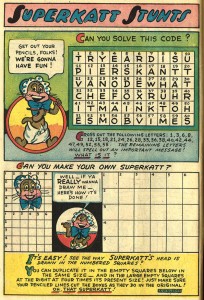 Superkatt creeps into the kitchen, and hides in a kitchen trash can with foot pedal control for its lid. The mouse spots the approach, but plays it cool util the can is in the can – then drops a full can of flour onto the foot pedal. The cat is rocketed out of the trash, and the mouse uses the old cliche dialogue, “Look, in the sky. It’s a bird. It’s a plane. It’s a bat.” “It’s Superkatt!” yells our hero – upon which he crashes headfirst into the ceiling, then makes a hole in the kitchen table upon return to terra firma. The mouse takes strategic position in a mousehole, while Superkatt ponders his double’s exploits in the comics for inspiration. The comic cat is seen in a panel with a large contraptive device, decreeing the motto, “Traps never fail!” Faster than you can say, “camera wipe”, Superkatt has built a duplicate of the comic device, with sign reading “Superkatt’s never-fail mouse trap”, consisting of a bull’s eye platform with standard mousetrap-like trigger mechanism baited with cheese, above which looms a tall structure holding up a 500 pound bag of flour (though its size looks more like 50 lbs.). Standard fare as the mouse goes for the cheese, tugs, pulls, prys, and kicks at the cheese stuck to the trigger, until it finally pulls off with considerable effot, allowing him to take the morsel home – all without any effect to activate the trap. With no surprise, the lightest touch by Superkatt brings the flour sack down on him – the other side of the sack containing an advertising slogan – “Light as a feather.”
Superkatt creeps into the kitchen, and hides in a kitchen trash can with foot pedal control for its lid. The mouse spots the approach, but plays it cool util the can is in the can – then drops a full can of flour onto the foot pedal. The cat is rocketed out of the trash, and the mouse uses the old cliche dialogue, “Look, in the sky. It’s a bird. It’s a plane. It’s a bat.” “It’s Superkatt!” yells our hero – upon which he crashes headfirst into the ceiling, then makes a hole in the kitchen table upon return to terra firma. The mouse takes strategic position in a mousehole, while Superkatt ponders his double’s exploits in the comics for inspiration. The comic cat is seen in a panel with a large contraptive device, decreeing the motto, “Traps never fail!” Faster than you can say, “camera wipe”, Superkatt has built a duplicate of the comic device, with sign reading “Superkatt’s never-fail mouse trap”, consisting of a bull’s eye platform with standard mousetrap-like trigger mechanism baited with cheese, above which looms a tall structure holding up a 500 pound bag of flour (though its size looks more like 50 lbs.). Standard fare as the mouse goes for the cheese, tugs, pulls, prys, and kicks at the cheese stuck to the trigger, until it finally pulls off with considerable effot, allowing him to take the morsel home – all without any effect to activate the trap. With no surprise, the lightest touch by Superkatt brings the flour sack down on him – the other side of the sack containing an advertising slogan – “Light as a feather.”
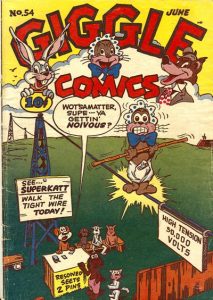 Another glance through the comics prompts a reaction from Superkatt, “This one can’t miss.” He trues a vacuum cleaner to suck the mouse out. The mouse opens a panel on the other side of the wall, exposing a bulldog in the next apartment to the power of the suction. As something lands with a clunk in the vacuum bag, Superkatt tosses the bag against the floor, then stomps on it. With no surprising payoff, the contents are of course the bulldog, who briefly tosses the cat around violently in his jaws. Superkatt tries an array of high explosives around the mousehole, fueled by a trail on black powder. Predicting Friz Freleng’s use of similar gag a few years later in “Bunker Hill Bunny”, the mouse sweeps away a portion of the powder, then lights the remainder from his end before Superkatt has finished pouring the trail. The flame travels back to Superkatt, and jumps right into the spout of the powder can. Knowing this can’t be good, Superkatt lays the can down withe the greatest of gentle care, and raises one foot to beat a hasty exit. Too late……BLAM! , as a powder-dusted cat remains frozen in his tracks, and tips over onto the floor. In the final sequence, Superkatt lies in wait as the mouse ventures out of his hole for a look-see – and narrowly misses getting clipped by a pair of pruning shears held by the cat. The mouse makes a game out of it, poking his head and his rear end out of the hole at intervals for more near-misses, then performs a highland fling dance jumping at intervals between the blades. He brings a halt to the blade attacks by emerging again from the mousehole, wearing a lead pipe around his neck, on which the shears clank with reverberating effect upon the cat. Having had enough, Superkatt performs his only feat of super-strength – taking hold of the wall baseboard, and pushing the whole wall panel upwards into the ceiling, exposing the wooden framework within the wall. But the mouse is no longer inside, and appears behind the cat on the opposite side of the room, carrying a slingshot. He takes aim with a rock upon Superkatt’s diaper, scoring a direct hit which causes the cat to lose his grip upon the wall – which comes crashing down behind him, trapping the cat inside the mousehole. The mouse reenters the room, carrying a giant stick of TNT, which he places just outside the mousehole with fuse lit. Only Superkatt’s head can emerge from the mousehole, as he hopelessly blows puffs of air to extinguish the fuse. No such luck. From the settling dust of the explosion, we see the comic book, and the upper tips of the baby bonnet worn by its hidden reader, who declares again, “This one can’t miss!” However, this time the reader is the mouse, not the cat, who ends the film posing for us with the bonnet worn at rakish angle, for the iris out.
Another glance through the comics prompts a reaction from Superkatt, “This one can’t miss.” He trues a vacuum cleaner to suck the mouse out. The mouse opens a panel on the other side of the wall, exposing a bulldog in the next apartment to the power of the suction. As something lands with a clunk in the vacuum bag, Superkatt tosses the bag against the floor, then stomps on it. With no surprising payoff, the contents are of course the bulldog, who briefly tosses the cat around violently in his jaws. Superkatt tries an array of high explosives around the mousehole, fueled by a trail on black powder. Predicting Friz Freleng’s use of similar gag a few years later in “Bunker Hill Bunny”, the mouse sweeps away a portion of the powder, then lights the remainder from his end before Superkatt has finished pouring the trail. The flame travels back to Superkatt, and jumps right into the spout of the powder can. Knowing this can’t be good, Superkatt lays the can down withe the greatest of gentle care, and raises one foot to beat a hasty exit. Too late……BLAM! , as a powder-dusted cat remains frozen in his tracks, and tips over onto the floor. In the final sequence, Superkatt lies in wait as the mouse ventures out of his hole for a look-see – and narrowly misses getting clipped by a pair of pruning shears held by the cat. The mouse makes a game out of it, poking his head and his rear end out of the hole at intervals for more near-misses, then performs a highland fling dance jumping at intervals between the blades. He brings a halt to the blade attacks by emerging again from the mousehole, wearing a lead pipe around his neck, on which the shears clank with reverberating effect upon the cat. Having had enough, Superkatt performs his only feat of super-strength – taking hold of the wall baseboard, and pushing the whole wall panel upwards into the ceiling, exposing the wooden framework within the wall. But the mouse is no longer inside, and appears behind the cat on the opposite side of the room, carrying a slingshot. He takes aim with a rock upon Superkatt’s diaper, scoring a direct hit which causes the cat to lose his grip upon the wall – which comes crashing down behind him, trapping the cat inside the mousehole. The mouse reenters the room, carrying a giant stick of TNT, which he places just outside the mousehole with fuse lit. Only Superkatt’s head can emerge from the mousehole, as he hopelessly blows puffs of air to extinguish the fuse. No such luck. From the settling dust of the explosion, we see the comic book, and the upper tips of the baby bonnet worn by its hidden reader, who declares again, “This one can’t miss!” However, this time the reader is the mouse, not the cat, who ends the film posing for us with the bonnet worn at rakish angle, for the iris out.
 Super Lulu (Paramount/Famous, Little Lulu, 11/21/47. Bill Tytla, dir) – Lulu’s father comes home from a hard day’s work to find Lulu engaged in a litte light reading – aloud, from a pile of pulp magazines labeled “Super Comics”. Her sound effects and gestures resemble the average decibel level of an episode of radio’s “Gang Busters”, and upset Mr. Moppet no end. “Why do you read this stuff?”, he asks. “They’re simply Super, Daddy”, replies Lulu. Dad grabs away the magazine, and hand her a book from a bookshelf. “Here. Read something sensible”, and sends her to her room, while he attempts to hang up his coat in the closet – make that Fibber McGee’s closet, which Lulu has stacked to capacity with back issues or even more comic books!
Super Lulu (Paramount/Famous, Little Lulu, 11/21/47. Bill Tytla, dir) – Lulu’s father comes home from a hard day’s work to find Lulu engaged in a litte light reading – aloud, from a pile of pulp magazines labeled “Super Comics”. Her sound effects and gestures resemble the average decibel level of an episode of radio’s “Gang Busters”, and upset Mr. Moppet no end. “Why do you read this stuff?”, he asks. “They’re simply Super, Daddy”, replies Lulu. Dad grabs away the magazine, and hand her a book from a bookshelf. “Here. Read something sensible”, and sends her to her room, while he attempts to hang up his coat in the closet – make that Fibber McGee’s closet, which Lulu has stacked to capacity with back issues or even more comic books!
Upstairs in her room, Lulu discovers her reading assignment for the evening to be a copy of “Jack and the Beanstalk”. “Aw, this Jackson’s an icky. What’s super about him?”, Lulu complains. She tries to pass the time instead by changing her wardrobe, with a box marked, “Super Suit”. She emerges from behind a dressing curtain in the guise of “Super Lulu”, giving herself the “it’s a bird. It’s a plane” imtro, and taking a flying leap onto the bed – then bouncing off onto the floor. Papa complains about the noise, and Lulu decides to behave and finish the book. When she reaches the “happily ever after”, she can only comment, “What corn. I don’t believe it.” The boring story makes her drift off to dreamland. There, her father, now in the role of the magic bean vendor, attempts to instill belief in the doubting Thomas by planing one of the beans in the ground. Living up to his advertisement, the seed sprouts a giant beanstalk. Unfortunately, its tendrils catch Papa’s coat, and drag him upward into the sky. Lulu begins a climb to save Daddy. The ascent is long and arduous – at one point Lulu climbs right through a hole in a star the beanstalk drilled on its way up.
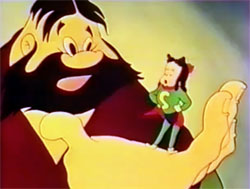 Arriving at the castle in the clouds, Lulu encounters a typical giant, with a somewhat atypical magic hen, who instead of golden eggs, lays Faberge eggs with viewfinders, revealing live images of Western dance hall girls entertaining inside. “Is my Daddy in there?”, Lulu asks the over-stimulated giant. No – Daddy is locked in a birdcage, presumably to be the giant’s next main course for dinner. The giant grabs Lulu away from the cage, but when he opens his hand, Lulu has made a quick costume change to Super Lulu. As she claims to be stronger than any giant, the giant asks, “Well, let’s see how strong you are”, and challenges her to a round of arm-wrestling. While the giant shows the initial advantage, Lulu forces his arm backward, and wins the match – then judo flips the giant over her shoulder, snashing him into a cuckoo clock on the wall, with the predictable gag of the cuckoo bird coming out of his mouth. The giant picks up a massive club, and as Lulu flies toward him, attempts to bat her for a home run. His blow has no effect on Lulu, but instead stops the giant in his tracks, as if he just attempted to strike a stone wall, leaving him vibrating in place – while Lulu takes the club, and knocks him through the flooring into the castle basement. Climbing out of the hole, the giant attempts to load a huge slingshot with a rock intended for Lulu – until Lulu grabs the rubber launcher of the slihot away from the giant and backwards over the dinner table.
Arriving at the castle in the clouds, Lulu encounters a typical giant, with a somewhat atypical magic hen, who instead of golden eggs, lays Faberge eggs with viewfinders, revealing live images of Western dance hall girls entertaining inside. “Is my Daddy in there?”, Lulu asks the over-stimulated giant. No – Daddy is locked in a birdcage, presumably to be the giant’s next main course for dinner. The giant grabs Lulu away from the cage, but when he opens his hand, Lulu has made a quick costume change to Super Lulu. As she claims to be stronger than any giant, the giant asks, “Well, let’s see how strong you are”, and challenges her to a round of arm-wrestling. While the giant shows the initial advantage, Lulu forces his arm backward, and wins the match – then judo flips the giant over her shoulder, snashing him into a cuckoo clock on the wall, with the predictable gag of the cuckoo bird coming out of his mouth. The giant picks up a massive club, and as Lulu flies toward him, attempts to bat her for a home run. His blow has no effect on Lulu, but instead stops the giant in his tracks, as if he just attempted to strike a stone wall, leaving him vibrating in place – while Lulu takes the club, and knocks him through the flooring into the castle basement. Climbing out of the hole, the giant attempts to load a huge slingshot with a rock intended for Lulu – until Lulu grabs the rubber launcher of the slihot away from the giant and backwards over the dinner table.
She continues pulling until she reaches a giant-sized tomato on the table, and lowers the rubber band around the tomato, then lets go. The vegetable strikes the giant in the kisser before he knows what hit him. When he looks dowsn at the splattered red mess, he assumes the worst. “B-Blood. My blood!”, and faints dead away, while Lulu wipes her feet upon his chest as if he were a doormat, to the cheers of Papa – “That’s my little girl!”
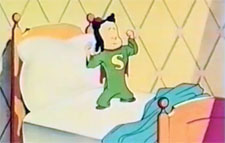 The scene fades back to reality, and we find the picture’s not over yet. Lulu hears the muffled voice of her father downstairs. Still wearing her super suit, she peers down the stairs, to see Papa bound and gagged in a chair, while a burglar stashes the silverwear into a sack. Lulu “soars” to the rescue – by sliding down the bannister and zooming off its end, where she encounters the chandelier above Daddy and the villain, ripping it from the ceiling. It lands upon the robber, encircling him and winding its support chain around him, then conking him on the head with its brass mounting. Lulu stands atop the unconscious hoodlum, shouting her battle cry: “I did it – – and I’m glad!” In the final scene, some time later, Papa, impressed with Lulu’s valor, joins Lulu as the newest devotee to the comic book, reading gangster lines and rendering sound effects in the same manner as Lulu did at the opening of the picture. The comic book lowers to reveal Daddy now dressed in his own super suit, as both he and Lulu join in the closing cry, “It’s Super!”
The scene fades back to reality, and we find the picture’s not over yet. Lulu hears the muffled voice of her father downstairs. Still wearing her super suit, she peers down the stairs, to see Papa bound and gagged in a chair, while a burglar stashes the silverwear into a sack. Lulu “soars” to the rescue – by sliding down the bannister and zooming off its end, where she encounters the chandelier above Daddy and the villain, ripping it from the ceiling. It lands upon the robber, encircling him and winding its support chain around him, then conking him on the head with its brass mounting. Lulu stands atop the unconscious hoodlum, shouting her battle cry: “I did it – – and I’m glad!” In the final scene, some time later, Papa, impressed with Lulu’s valor, joins Lulu as the newest devotee to the comic book, reading gangster lines and rendering sound effects in the same manner as Lulu did at the opening of the picture. The comic book lowers to reveal Daddy now dressed in his own super suit, as both he and Lulu join in the closing cry, “It’s Super!”
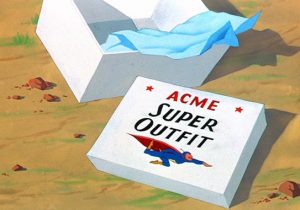 Fast and Furry-ous (Warner, Road Runner, 9/17/49 – Charles M (Chuck) Jones, dir.) – The premiere entry in the road runner series – and already the coyote’s schemes assume grandiose proportions. Among them, a quick sequence has Wile E. ordering an Acme Super Suit. It’s not quite a Superman design though it uses traditional blue with red cape – and adds a hood-style cap that predicts the look Jones would create a few years later for Duck Dodgers. The dashing coyote starts at a slow trot, builds up speed, then takes a headlong leap in flying position off a cliff – and straight down. (The gag simply fades out to the next sequence. In later years, Jones might have thought to add the bedraggled coyote discovering an overlooked instruction sheet, reading “Caution: Does Not Fly.”)
Fast and Furry-ous (Warner, Road Runner, 9/17/49 – Charles M (Chuck) Jones, dir.) – The premiere entry in the road runner series – and already the coyote’s schemes assume grandiose proportions. Among them, a quick sequence has Wile E. ordering an Acme Super Suit. It’s not quite a Superman design though it uses traditional blue with red cape – and adds a hood-style cap that predicts the look Jones would create a few years later for Duck Dodgers. The dashing coyote starts at a slow trot, builds up speed, then takes a headlong leap in flying position off a cliff – and straight down. (The gag simply fades out to the next sequence. In later years, Jones might have thought to add the bedraggled coyote discovering an overlooked instruction sheet, reading “Caution: Does Not Fly.”)
Swallow the Leader (Warner, 10/14/49, Robert McKimson, dir.) – Only one sequence of this clever episode concerns this article. A “bird lover” waits for the annual return of the swallows to San Juan Capistrano mission. He just happens to have black fur, pointed ears, whiskers and a long tail – and his interests are purely culinary. In pursuing the advance scout of the swallow flock, the cat employs various methods of trickery, contrivance, and disguise – at one point mail-ordering a la Wile E. Coyote for a super suit – matching in every detail to the traditional costume of the man of steel. Unbeknownst to him, while he is dressing, the swallow is hooking to the back of his cape a length of rope, which in tuen is connected to a spring, which in turn is fastened to the rope for the bucket of the mission’s old well. The cat climbs a ladder to the mission roof in search of his prey. The swallow does not disappoint, and hovers between buildings as if to say, “Here I am.” Backing up several steps, the cat begins a running start to take a heroic flying leap off the roof. The rope is measured just so – and stops the cat halfway to his prey – then the spring pulls him backwards, dropping him neatly into the well. The charitable swallow is a good sport, and hauls the cat up by the well’s winch, with the dripping, water-logged cat now cutting a figure that looks anything but heroic.

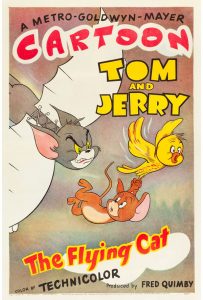 The Flying Cat (MGM, Tom and Jerry, 1/12/52 – William Hanna/Joseph Barbera, dir.) – Maybe a bit of a stretch for the category of these articles, but the closest thing the Tom and Jerry series came to in endowing a character with a “superpower” from an unlikely source. And it feels so similar to the contraptiveness of Wile E. Coyote (in fact predicting a coyote setup which will be discussed in next week’s article) that I simply can’t resist including it.
The Flying Cat (MGM, Tom and Jerry, 1/12/52 – William Hanna/Joseph Barbera, dir.) – Maybe a bit of a stretch for the category of these articles, but the closest thing the Tom and Jerry series came to in endowing a character with a “superpower” from an unlikely source. And it feels so similar to the contraptiveness of Wile E. Coyote (in fact predicting a coyote setup which will be discussed in next week’s article) that I simply can’t resist including it.
It’s just a typical, action-packed day around the T&J household. Tom has his eyes today upon poultry instead of rodents, making off with the bird cage of the small canary that became Jerry’s friend in 1948’s Kitty Foiled An extended foot of Jerry causes the cat to trip, and the birdcage to break open, releasing the dazed canary. One good turn deserves another, and with Tom now pursuing Jerry, the bird stretches one line of a clothesline down to Tom’s neck level, catching him in the wire and flipping him atop and through the remaining wires of the clotheslines – which slice Tom into multiple segments like an egg slicer. A swipe by Tom at the bird with an axe chops down a telephone pole instead, pounding Tom into a short squat form. The mouse and bird take refuge in a backyard birdhouse, and when Tom climbs the birdhouse pole, he is brought quickly down to Earth again by being handed a 2,000 pound weight by the canary. (Wow. Has the bird ever considered producing workout videos?) .
Tom must find a way to infiltrate the birdhouse. A wooden ladder is a bad choice, as the canary sets it on fire. Tom mounts a tree swing, and swings close enough to reach across with his paws and grab the platform of the birdhouse – intil Jerry and the canary stomp on his paws, causing Tom to lose his grip and swing face-first into the lawn. A pole vault gets Tom the elevation – but not the range, due to the canary placing a roller skate in the prescise spot where Tom plants the pole. Tom rolls right past the birdhouse, into the upper window of the main home, and clear through the top floor out the back window, where he dangles out a chest of drawers from some wire-studded ladies’ corsetry. The garment stretches and deposits Tom on the ground, where he comes up with the garment strapped between his arms and legs and laced in the back – functionally taking the form of perfect bat-wings! (While not technically written as a superhero spoof, this film may mark the first Hollywood cartoon to take visual inspiration from the imagery of DC comics’ #2 superhero, Batman – although some may argue it could have been equally inspired by Disney’s 1934 classic, The Flying Mouse.)
 Tom tightens up his support straps, and tries the contraption to see if it’ll work. To his fiendish glee, he soars effortlessly across the yard, in masterfully smooth perspective animation. Predicting Wile E. Coyote situations yet to come, Tom is so pleased with himself that he shows off for the audience and makes eyes at the camera – only to forget to look where he is going, and smash headfirst into the mailbox. (A similarly-timed flying sequence would be reused in Cinemascope a few seasons later, on board a broomstick, in the team’s Halloween special, The Flying Sorceress.)
Tom tightens up his support straps, and tries the contraption to see if it’ll work. To his fiendish glee, he soars effortlessly across the yard, in masterfully smooth perspective animation. Predicting Wile E. Coyote situations yet to come, Tom is so pleased with himself that he shows off for the audience and makes eyes at the camera – only to forget to look where he is going, and smash headfirst into the mailbox. (A similarly-timed flying sequence would be reused in Cinemascope a few seasons later, on board a broomstick, in the team’s Halloween special, The Flying Sorceress.)
Jerry attempts to spend a peaceful afternoon of reading in the canary’s newfound living room atop the pole. A passing shadow calls his attention to peep out the birdhouse hole. There is Tom, soaring in graceful circles around and around the pole. After a double take, Jerry rouses the sleeping canary, and pantomimes with pointed teeth and stretching his ears to a point the menace outside. The bird thinks Jerry is joking, and bursts out laughing, but the mouse persists in tugging the stubborn bird over to the hole. The bird steps a little too far outside for a glance – and finds himself directly in Tom’s flight path.
Nearly shedding all his feathers in fright, the canary takes off with Tom in pursuit. They circle and buzz the neighborhood, coming up inside the bell of the local church steeple with a resounding clang. The bird doubles back to the birdhouse, where Jerry waits for him, and the two combine their strength to pull the panels of the birdhouse roof off the house and turn them inside out – revealing a perimeter of large protruding nails. Tom can’t put on the air brakes, and lands painfully seated upon the bed of nails. With his trademark scream, Tom jumps off, landing in a backyard fish pond below. He hears the sound of water filling a receptacle below the surface of the pond – and realizes the receptacle is him! Standing up, holes from Tom’s perforated rear end provide the effect of a watering can, pouring fountais of water upon nearby rose bushes. Jerry takes this opportunity to slide down the pole and try to head for home. But, in a dramatically-timed shot, the shadow of Tom, again airborne, grows larger and larger upon the ground around him, and the mouse is too late to take heed, as Tom catches Jerry up in his paws on the fly. The horrified canary chirps a shrill scream, and flies to the rescue. Zooming in above Tom’s back, the canary grabs hold with his beak of the corset strings tied behind Tom’s back, and undoes the supporting knot. The lacing gives way, leaving Tom’s “wings” loose and flapping uncontrollably below his arms. Unable to capture any air currents, Tom falls helplessly, intersecting the top of a tall tree with his legs in spread-eagle position. The force of the impact saws the entire tree in two down the middle, with Tom stepping out from the crotch of the tree with his own crotch massively extended both in height and width. Somehow, relentless Tom still gets his lacings back under control, and takes off after the canary, who now carries Jerry by his feet, having saved him when Tom took his fall. The bird leads Tom into a railway tunnel – then Tom screams, and attempts to learn to fly backwards, as a streamlined train smacks straight into him. Tom is flattened and becomes suspended by his tail from a crossing gate, swinging back and forth with bell clangs as if a crossing signal, while the train passes. On board the last car, Jerry and the canary emerge, and shake hands in victory for the iris out. (Many scenes of this film may appear familiar to fans of the CBS broadcasts of the series, or to those who saw the same network intros reused in later years on local syndications – as at least three or four sequences from this fan favorite were included in the clip montage for the network opening.)
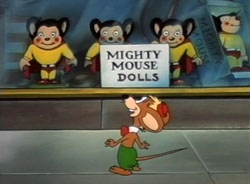 Hero For a Day (Terrytoons, Fox, Mighty Mouse, 3/3/52 – Mannie Daivs, dir.) – A country mouse (voiced in similar fashion to Edgar Bergen’s ventriloquist dummy Mortimer Snerd – the inspiration for Beaky Buzzard) visits his girlfriend Susie, armed with a bouquet of posies. He receives a cool reception, when he discovers his girl has received an autographed picture of Mighty Mouse, and developed a crush on his muscular physique. “What’s he got that I haven’t got?”, the little mouse asks, and flexes an arm muscle that looks more like a wart. Giggling, his girlfriend presses on the muscle, easily forcing it to descend from upper arm to a droop out his lower arm. “Take it easy. That’s the only muscle I’ve got”, complains our spurned Romeo. As his girl returns to embracing the photograph, the country mouse sadly drops his bouquet and wanders away. In his travels, he encounters the attention of three cats who wouldn’t mind adding him to their menu. However, the little mouse remains largely unaware of their attentions, as their leaps overshoot him or cause them to merely butt heads with each other. What does attract out little mouse’s attention is a toy store window, displaying a line of Mighty Mouse dolls. “That gives me an idea”, says the mouse. Slipping under the front door, the mouse reemerges carrying a new yellow and red wardrobe, while in the store window, one doll has been reduced to his underwear. At home, the little mouse tries on hs new heroic apparel, adding the finishing touch by inflating a large balloon inside the chest cavity of the shirt, and two smaller balloons inside the sleeves. “If its muscles she wants, muscles she’s gonna get”, vows the mouse.
Hero For a Day (Terrytoons, Fox, Mighty Mouse, 3/3/52 – Mannie Daivs, dir.) – A country mouse (voiced in similar fashion to Edgar Bergen’s ventriloquist dummy Mortimer Snerd – the inspiration for Beaky Buzzard) visits his girlfriend Susie, armed with a bouquet of posies. He receives a cool reception, when he discovers his girl has received an autographed picture of Mighty Mouse, and developed a crush on his muscular physique. “What’s he got that I haven’t got?”, the little mouse asks, and flexes an arm muscle that looks more like a wart. Giggling, his girlfriend presses on the muscle, easily forcing it to descend from upper arm to a droop out his lower arm. “Take it easy. That’s the only muscle I’ve got”, complains our spurned Romeo. As his girl returns to embracing the photograph, the country mouse sadly drops his bouquet and wanders away. In his travels, he encounters the attention of three cats who wouldn’t mind adding him to their menu. However, the little mouse remains largely unaware of their attentions, as their leaps overshoot him or cause them to merely butt heads with each other. What does attract out little mouse’s attention is a toy store window, displaying a line of Mighty Mouse dolls. “That gives me an idea”, says the mouse. Slipping under the front door, the mouse reemerges carrying a new yellow and red wardrobe, while in the store window, one doll has been reduced to his underwear. At home, the little mouse tries on hs new heroic apparel, adding the finishing touch by inflating a large balloon inside the chest cavity of the shirt, and two smaller balloons inside the sleeves. “If its muscles she wants, muscles she’s gonna get”, vows the mouse.
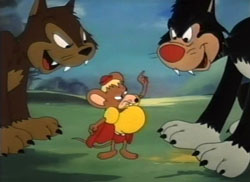 Arranging a slingshot in the ground, the mouse plans a heroic entrance by air to arrive at his girl’s front door. The grace of the entrance is spoiled when the balloons cause him to bounce on the landing like a rubber ball. “You’ll never be a mighty mouse”, laughs his girl. But a sight over our star’s shoulder wipes the smile off of his girl’s face, and causes her to duck for cover back into the safety of her home. The three cats have gotten together on things, and arrived en masse to confront the little mouse. The little mouse chooses this inopportune moment to boast, “It there were only some cats around here, I’d show ya. You’d see.” Looking up, he discovers he’s just gotten his wish. “A muscle man”, jeers one of the cats. The mouse’s heart leaps into his throat, but, realizing he still has the suit, he tries to call the cats’ bluff. “Don’t start nothin’ with me or I’ll flatten ya”, he declares. Regrettably, he gestures to himself with an outstretched thumb to the chest – and pops the large balloon, leaving a torn hole and a sagging midriff to his super suit. Two of the cats pop out their claws like switchblades, and each pops one of the remaining shoulder balloons. The mouse is left a tattered, scrawny mess. Just to test out what the mouse has got in him without his suit, one cat pushes his face close to the mouse, and bats an eyelash at him – which is more than enough to knock the little mouse down. A chase ensues, in which the mouse stumbles over a rock, and knocks himself unconscious on the ground, The three cats race in for the kill, and leap in a group pounce toward their target. Who should arrive, ever vigilant and without even a distress call, to save the day? “It’s him!” “In person!” “MIGHTY MOUSE!!”, shout the cats, freezing in mid air before reaching their victim. The three cats turn and, still suspended by nothing but air, attempt to quietly tiptoe away – until gravity takes over and lands them on the ground. A first cat gets the same treatment from Mighty that he gave to the little mouse – with Mighty knocking him over with a mere flick of a finger. The other two cats charge Mighty with a battering ram, but Mighty launches into a forward spin, transforming into a human saw-blade and cutting the log in two.
Arranging a slingshot in the ground, the mouse plans a heroic entrance by air to arrive at his girl’s front door. The grace of the entrance is spoiled when the balloons cause him to bounce on the landing like a rubber ball. “You’ll never be a mighty mouse”, laughs his girl. But a sight over our star’s shoulder wipes the smile off of his girl’s face, and causes her to duck for cover back into the safety of her home. The three cats have gotten together on things, and arrived en masse to confront the little mouse. The little mouse chooses this inopportune moment to boast, “It there were only some cats around here, I’d show ya. You’d see.” Looking up, he discovers he’s just gotten his wish. “A muscle man”, jeers one of the cats. The mouse’s heart leaps into his throat, but, realizing he still has the suit, he tries to call the cats’ bluff. “Don’t start nothin’ with me or I’ll flatten ya”, he declares. Regrettably, he gestures to himself with an outstretched thumb to the chest – and pops the large balloon, leaving a torn hole and a sagging midriff to his super suit. Two of the cats pop out their claws like switchblades, and each pops one of the remaining shoulder balloons. The mouse is left a tattered, scrawny mess. Just to test out what the mouse has got in him without his suit, one cat pushes his face close to the mouse, and bats an eyelash at him – which is more than enough to knock the little mouse down. A chase ensues, in which the mouse stumbles over a rock, and knocks himself unconscious on the ground, The three cats race in for the kill, and leap in a group pounce toward their target. Who should arrive, ever vigilant and without even a distress call, to save the day? “It’s him!” “In person!” “MIGHTY MOUSE!!”, shout the cats, freezing in mid air before reaching their victim. The three cats turn and, still suspended by nothing but air, attempt to quietly tiptoe away – until gravity takes over and lands them on the ground. A first cat gets the same treatment from Mighty that he gave to the little mouse – with Mighty knocking him over with a mere flick of a finger. The other two cats charge Mighty with a battering ram, but Mighty launches into a forward spin, transforming into a human saw-blade and cutting the log in two.
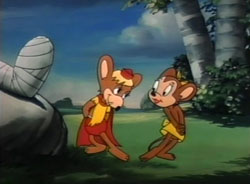 The first cat tosses a wooden spear at our hero. Mighty grabs the spear in mid-air, then launches it back at the cat. The cat ducks into a hollow tree, as the spear flies into the hole, then protrudes out the other side of the tree, the cat’s fur hanging like a bedraggled garment from the spear point, as the cat emerges from the tree hole in red flannel underwear to retrieve his “garment”. From inside a barrel, another cat fires at Mighty with a rifle. Mighty socks the bullets out of his flight path, then bends back the barrel of the gun to point directly into the wooden barrel. Another shot from the cat blasts the barrel apart, leaving the cat in a duplication of Tom and Jerry’s old “sunflower” gag, with the cat’s blackened face in the center of a circle of board “petals”. A leap by another cat causes Mighty to belt the cat skyward under the overhanging branches of a nearby tree. The cat soars upward, knocking branch after branch off the tree with his head. The wooden debris falling from the tree assembles and takes the shape of a wooden wheel chair with the battered cat landing in the driver’s seat. The cat wheels himself away for a hasty exit, encounters a rock obstacle, and bounces onto another rock, knocked unconscious. Mighty delivers finishing blows to the other two cats, who land atop the shoulders of the first cat, forming a feline totem pole. So what to do about the little mouse who wanted to be mighty? Leave him placed at the foot of the totem pole, to awaken to find his adversaries vanquished. More surprised than the little mouse is his girlfriend, who finally looks out her door to see the amazing sight. “You’re my big strong hero”, she says to the little mouse, embracing him. “Gosh, I didn’t know I had it in me”, replies the mouse. The girl plants several kisses on him – and then more girls from the community also surround him with attention. “Take it easy” he cheerily tells the,. “One at a time. There’s room for everybody!” From behind a tree, Mighty gives the audience a wink, and, with another job well down, heads off in search of his next adventure.
The first cat tosses a wooden spear at our hero. Mighty grabs the spear in mid-air, then launches it back at the cat. The cat ducks into a hollow tree, as the spear flies into the hole, then protrudes out the other side of the tree, the cat’s fur hanging like a bedraggled garment from the spear point, as the cat emerges from the tree hole in red flannel underwear to retrieve his “garment”. From inside a barrel, another cat fires at Mighty with a rifle. Mighty socks the bullets out of his flight path, then bends back the barrel of the gun to point directly into the wooden barrel. Another shot from the cat blasts the barrel apart, leaving the cat in a duplication of Tom and Jerry’s old “sunflower” gag, with the cat’s blackened face in the center of a circle of board “petals”. A leap by another cat causes Mighty to belt the cat skyward under the overhanging branches of a nearby tree. The cat soars upward, knocking branch after branch off the tree with his head. The wooden debris falling from the tree assembles and takes the shape of a wooden wheel chair with the battered cat landing in the driver’s seat. The cat wheels himself away for a hasty exit, encounters a rock obstacle, and bounces onto another rock, knocked unconscious. Mighty delivers finishing blows to the other two cats, who land atop the shoulders of the first cat, forming a feline totem pole. So what to do about the little mouse who wanted to be mighty? Leave him placed at the foot of the totem pole, to awaken to find his adversaries vanquished. More surprised than the little mouse is his girlfriend, who finally looks out her door to see the amazing sight. “You’re my big strong hero”, she says to the little mouse, embracing him. “Gosh, I didn’t know I had it in me”, replies the mouse. The girl plants several kisses on him – and then more girls from the community also surround him with attention. “Take it easy” he cheerily tells the,. “One at a time. There’s room for everybody!” From behind a tree, Mighty gives the audience a wink, and, with another job well down, heads off in search of his next adventure.
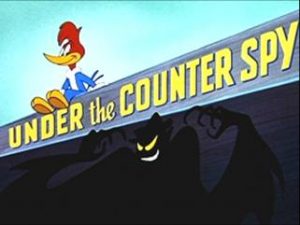 Under the Counter-Spy (Laniz/Universal, Woody Woodpecker, 5/10/54 – Don Patterson, dir.) – In a clever and original concept, super strength mixes with one of the first full-blown cartoon parodies upon Jack Webb’s popular “Dragnet” series, having moved from radio to television. Beginning with an intertitle, Lantz first parodies the standard disclaimer from the opening of the TV show: “The story you are about to see is a big fat lie. No names have been changed to protect anybody!” Emulating the low-key investigative style that often kept action budgets to a minimum in the live-action production (and made life easier for star Webb in avoiding too much strenuous activity), the cartoon opens on a nearly motionless routine day for officer “Thursday” (Webb’s character was Joe Friday) and his assistant in “spy detail”. Not only do the characters barely budge behind their desks, but even an incoming phone call makes them waste four lines of dialogue as to who will pick it up, followed by merely kicking the handset off the cradle to Thursday’s ear, rather than raise a hand to lift it. The officers are finally forced to at least look up a file folder, for notorious international spy, “The Bat”, who has stolen a top secret formula from an experimental lab. “We moved fast”, narrates Thursday – as their squad car is seen proceeding at about two miles an hour. The Bat (who has the appearance of a real one, and even hangs out with the creepy creatures upside down in a tree), hears sirens, and decides to ditch the incriminating evidence as the cops pass, briefly slipping the bottle of secret formula into an apartment window. As the lights of the squad car fade away, the Bat reaches into the window for the bottle, then vanishes into the night – not realizing he’s actually picked up a second bottle on the same counter – a prescription “redwood sap tonic” for Woody Woodpecker.
Under the Counter-Spy (Laniz/Universal, Woody Woodpecker, 5/10/54 – Don Patterson, dir.) – In a clever and original concept, super strength mixes with one of the first full-blown cartoon parodies upon Jack Webb’s popular “Dragnet” series, having moved from radio to television. Beginning with an intertitle, Lantz first parodies the standard disclaimer from the opening of the TV show: “The story you are about to see is a big fat lie. No names have been changed to protect anybody!” Emulating the low-key investigative style that often kept action budgets to a minimum in the live-action production (and made life easier for star Webb in avoiding too much strenuous activity), the cartoon opens on a nearly motionless routine day for officer “Thursday” (Webb’s character was Joe Friday) and his assistant in “spy detail”. Not only do the characters barely budge behind their desks, but even an incoming phone call makes them waste four lines of dialogue as to who will pick it up, followed by merely kicking the handset off the cradle to Thursday’s ear, rather than raise a hand to lift it. The officers are finally forced to at least look up a file folder, for notorious international spy, “The Bat”, who has stolen a top secret formula from an experimental lab. “We moved fast”, narrates Thursday – as their squad car is seen proceeding at about two miles an hour. The Bat (who has the appearance of a real one, and even hangs out with the creepy creatures upside down in a tree), hears sirens, and decides to ditch the incriminating evidence as the cops pass, briefly slipping the bottle of secret formula into an apartment window. As the lights of the squad car fade away, the Bat reaches into the window for the bottle, then vanishes into the night – not realizing he’s actually picked up a second bottle on the same counter – a prescription “redwood sap tonic” for Woody Woodpecker.
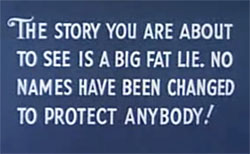 Next morning, an exhausted Woody Woodpecker slowly rises from his bed in the apartment. Instead of his usual flashy red and blue feathering, his entire body is seen in a sickly shade of green! Obviously, that prescription bottle was there for a reason. Woody drags himself to the bathroom, but can’t even muster the strength to squeeze his tube of toothpaste. He even tres his signature laugh – giving Grace Stafford her first chance on screen to voice the laugh in “sickly” mode, sounding hilariously weak and pathetic. It’s obviously time for some tonic. However, the bottle on the table now reads “DANGER! Formula 7 3/8. One drop = 50,000 horsepower.” Without attempting to read the label, Woody takes a swallow of the bottle’s contents. His eyes start to spin uncontrollably. He begins to squash and stretch in amazing contortions, changing color from red to purple, yellow to blue, and finally to his usual vibrant color tones. But something new has been added. He beats on his chest like Tarzan. He flexes his arm muscle, which swells so high from his arm that it hits him in the face. He returns to the bathroom – but rips the door entirely off the hinges. Squeezing the tube of toothpaste, he squirts its entire contents all over the room. Wondering what’s going on, he leans against a wall – and his hand knocks a hand-shaped hole clear through it. Figuring he needs some fresh air, Woody pushes upward on a window frame – and pushes the three flights of windows and brick wall above him upwards at the same time. Woody realizes that the tonic has somehow given him super strength, and decides to go out into the world and test it. Walking outside into the street, Woodt steps out into traffic, directly in the path of an approaching sedan. The car hits – but leaves Woody unscathed. However, the driver and his passenger react in shock, finding that their vehicle has been neatly sliced in two. Woody next spots a construction tractor attempting to tow a heavy safe up to the window of a tall building by means of a rope pulley. Woody grabs the rope and, with ease, lifts the safe nearly to the top of the building. Suddenly, that sickly green begins to return to the color of his feathers, and Woody realizes the tonic’s effects are wearing off. Unable to hold back the rope any longer, Woody lets go – causing the safe to smash through the pavement only inches ahead of his beak. And above him dangles the tractor, pulled skyward by the safe’s weight, with the driver shaking his fist at him. There’s nothing left for Woody to do but to drag himself back home, for another dose of tonic.
Next morning, an exhausted Woody Woodpecker slowly rises from his bed in the apartment. Instead of his usual flashy red and blue feathering, his entire body is seen in a sickly shade of green! Obviously, that prescription bottle was there for a reason. Woody drags himself to the bathroom, but can’t even muster the strength to squeeze his tube of toothpaste. He even tres his signature laugh – giving Grace Stafford her first chance on screen to voice the laugh in “sickly” mode, sounding hilariously weak and pathetic. It’s obviously time for some tonic. However, the bottle on the table now reads “DANGER! Formula 7 3/8. One drop = 50,000 horsepower.” Without attempting to read the label, Woody takes a swallow of the bottle’s contents. His eyes start to spin uncontrollably. He begins to squash and stretch in amazing contortions, changing color from red to purple, yellow to blue, and finally to his usual vibrant color tones. But something new has been added. He beats on his chest like Tarzan. He flexes his arm muscle, which swells so high from his arm that it hits him in the face. He returns to the bathroom – but rips the door entirely off the hinges. Squeezing the tube of toothpaste, he squirts its entire contents all over the room. Wondering what’s going on, he leans against a wall – and his hand knocks a hand-shaped hole clear through it. Figuring he needs some fresh air, Woody pushes upward on a window frame – and pushes the three flights of windows and brick wall above him upwards at the same time. Woody realizes that the tonic has somehow given him super strength, and decides to go out into the world and test it. Walking outside into the street, Woodt steps out into traffic, directly in the path of an approaching sedan. The car hits – but leaves Woody unscathed. However, the driver and his passenger react in shock, finding that their vehicle has been neatly sliced in two. Woody next spots a construction tractor attempting to tow a heavy safe up to the window of a tall building by means of a rope pulley. Woody grabs the rope and, with ease, lifts the safe nearly to the top of the building. Suddenly, that sickly green begins to return to the color of his feathers, and Woody realizes the tonic’s effects are wearing off. Unable to hold back the rope any longer, Woody lets go – causing the safe to smash through the pavement only inches ahead of his beak. And above him dangles the tractor, pulled skyward by the safe’s weight, with the driver shaking his fist at him. There’s nothing left for Woody to do but to drag himself back home, for another dose of tonic.
 Home again, Woody takes another drink, and again goes through the same metamorphosis. However, a bulletin broadcasts over his TV, warning to be on the lookout for the Bat, and displaying a picture of the missing formula bottle. Woody gets the notion that something’s wrong, and finally looks at his own bottle – a perfect match. The television announcer states that anyone who finds the bottle should return it at once to your nearest B.F. I. Office. By now, someone else has gotten wind that Woody has the bottle – the Bat himself, who lurks outside the window. Hearing the announcement, he produces from under his wing a convenient ready-made sign, reading, “To the B.F.I”. Placing the sign directly outside Woody’s door, he begins to direct Woody on a wild goose chase (including further signs with such inscriptions as “OK, son. You’re doing fine.”) A final sign identifies B.F.I. headquarters as a spooky old house in the woods. Upon entering the place, a giant padlock clacks shut on the front roor, sealing Woody in. A wall moves menacingly toward Woody from behind, and a picture is pushed aside to reveal a secret panel within its frame, and the Bat inside it. The Bat lifts a long sword and dashes it down upon Woody’s head. But Woody is so impervious to harm that he doesn’t even feel the blade, which bends into a spiral coil from the force of impact with Woody’s topknot, then straightens out again to sock the Bat in the chin, as the secret panel closes. The Bat slips up behind Woody with an axe, which merely shatters off its handle tpon striking the bird. Finally revealing himself, the Bat draws a gun on Woody. Woody fearlessly places one finger in the gun barrel, exploding the gun apart when fired. The impact of the shot, however, causes the formula bottle to be dropped and shatter, spilling its contents in the floor. As Woody looks down at the spillage, a lit black bomb is placed on his head by the Bat. As Woody straightens up, the bomb is tossed back at the villain. He flips the bomb back to Woody again. Now Woody performs his most amazing and unexpected feat of strength. Catching the bomb, he places his hanfs around it, and exerts a tremendous grip. The bomb begins to explode, expanding and developing red cracks throughout its exterior – yet Woody, gritting his teeth, compresses the bomb back to its original size, long enough to toss it back at the Bat. KABOOM!!! The bat is blown to the ceiling, then falls – where Woody waits, with an open trunk. The Bat falls in, and Woody slams the lid shut and padlocks the trunk.
Home again, Woody takes another drink, and again goes through the same metamorphosis. However, a bulletin broadcasts over his TV, warning to be on the lookout for the Bat, and displaying a picture of the missing formula bottle. Woody gets the notion that something’s wrong, and finally looks at his own bottle – a perfect match. The television announcer states that anyone who finds the bottle should return it at once to your nearest B.F. I. Office. By now, someone else has gotten wind that Woody has the bottle – the Bat himself, who lurks outside the window. Hearing the announcement, he produces from under his wing a convenient ready-made sign, reading, “To the B.F.I”. Placing the sign directly outside Woody’s door, he begins to direct Woody on a wild goose chase (including further signs with such inscriptions as “OK, son. You’re doing fine.”) A final sign identifies B.F.I. headquarters as a spooky old house in the woods. Upon entering the place, a giant padlock clacks shut on the front roor, sealing Woody in. A wall moves menacingly toward Woody from behind, and a picture is pushed aside to reveal a secret panel within its frame, and the Bat inside it. The Bat lifts a long sword and dashes it down upon Woody’s head. But Woody is so impervious to harm that he doesn’t even feel the blade, which bends into a spiral coil from the force of impact with Woody’s topknot, then straightens out again to sock the Bat in the chin, as the secret panel closes. The Bat slips up behind Woody with an axe, which merely shatters off its handle tpon striking the bird. Finally revealing himself, the Bat draws a gun on Woody. Woody fearlessly places one finger in the gun barrel, exploding the gun apart when fired. The impact of the shot, however, causes the formula bottle to be dropped and shatter, spilling its contents in the floor. As Woody looks down at the spillage, a lit black bomb is placed on his head by the Bat. As Woody straightens up, the bomb is tossed back at the villain. He flips the bomb back to Woody again. Now Woody performs his most amazing and unexpected feat of strength. Catching the bomb, he places his hanfs around it, and exerts a tremendous grip. The bomb begins to explode, expanding and developing red cracks throughout its exterior – yet Woody, gritting his teeth, compresses the bomb back to its original size, long enough to toss it back at the Bat. KABOOM!!! The bat is blown to the ceiling, then falls – where Woody waits, with an open trunk. The Bat falls in, and Woody slams the lid shut and padlocks the trunk.
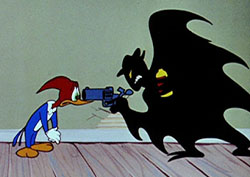 The final sequence returns to Thursday and his assistant, as motionless as ever behind their desks, allegedly preparing to run an APB but not moving a muscle. Their head are finally caused to turn as “a kid came in” – Woody, with the trunk, pantomiming how he captured the Bat. The officers open the trunk lid – to find that the Bat has pulled the slip on everyone – leaving inside the trunk a baseball “bat” and Woody’s bottle of redwood sap tonic. “Clever kid”, comments Thursday. For fun, they ask Woody to explain how he did it. Woody flexes a super muscle, then attempts to demonstrate his strength by running at a wall – just as his feathers turn green again. With a crash, Woody knocks himself out cold running into the wall. “Kid’s been watching too many television programs”, concludes Thursday. The final shot (missing from many TV prints) fades in on a mock-up of Webb’s “Mark VII Limited” production logo, where a hammer blow to a metal stamper lays an imprint of the logo in a metal sheet. In this version, the last hammer blow is misdirected, causing the holder of the stamper to strike his thumb with a loud “OUCH!, and the “The End” to be revealed imprinted on the background below.
The final sequence returns to Thursday and his assistant, as motionless as ever behind their desks, allegedly preparing to run an APB but not moving a muscle. Their head are finally caused to turn as “a kid came in” – Woody, with the trunk, pantomiming how he captured the Bat. The officers open the trunk lid – to find that the Bat has pulled the slip on everyone – leaving inside the trunk a baseball “bat” and Woody’s bottle of redwood sap tonic. “Clever kid”, comments Thursday. For fun, they ask Woody to explain how he did it. Woody flexes a super muscle, then attempts to demonstrate his strength by running at a wall – just as his feathers turn green again. With a crash, Woody knocks himself out cold running into the wall. “Kid’s been watching too many television programs”, concludes Thursday. The final shot (missing from many TV prints) fades in on a mock-up of Webb’s “Mark VII Limited” production logo, where a hammer blow to a metal stamper lays an imprint of the logo in a metal sheet. In this version, the last hammer blow is misdirected, causing the holder of the stamper to strike his thumb with a loud “OUCH!, and the “The End” to be revealed imprinted on the background below.
More 1950’s and beyond next time, as wanna-be Superguys begin to invade the small screen.


 Charles Gardner is an animation enthusiast who toils by day as a member of LA Law – but by nights and weekends indulges in classic jazz and ragtime as a performer; and studies classic Hollywood cartoons… maybe a little too much.
Charles Gardner is an animation enthusiast who toils by day as a member of LA Law – but by nights and weekends indulges in classic jazz and ragtime as a performer; and studies classic Hollywood cartoons… maybe a little too much.


































































































































































“Mighty Mouse” – that makes me wonder where is Super Mouse, the Mouse of Tomorrow?
Although you’ve probably never heard of the character, I would love to see you say something about Suppaman,the Superman parody created by manga legend Akira Toriyama. He’s a cowardly version of the Man Of Steel who lives in Penguin Village & goes under the secret identity of Clarku Kentu. Toriyama created him in his classic manga Dr. Slump in 1980 & he appeared in the anime version on tv in Japan as well as several of the movies. Suppaman also appeared in a couple of episodes of the Dragonball anime when the young Son Goku ventured into Penguin Village.
“Under the Counter-Spy” uses the Prelude to Act III of “Lohengrin” to accompany Woody’s transformation. I think this may be the first time that much-quoted classic had been used to signify “super-heroics” in a cartoon.
As a kid I had a tape of Tom and Jerry cartoons and “The Flying Cat” was first in the lineup, so I have a certain affection for it. I had no idea what that thing was that Tom was wearing (corsets were out of style by the 1980s), but I loved the flight sequences.
“Under the Counter Spy” was profiled on this blog (not updated in 5 years):
http://smokingholesthatwereoncemyeyes.blogspot.com/
Oh my dear God! Had not seen “ hero for a day” since…. since probbly the cbs days!!
I can’t wait for “Jerky Turkey” to be released remastered on a future “Tex Avery Screwball Classics” Volume from Warner Archive!
Oh, I wish Under the Counter Spy was much better… but there’s something just so unexpected and funny about some of its jokes. All right, it spells out and underlines all of its gags, but the Dragnet parody material works so well. It makes me laugh. Would that more of Mr. Lantz’ shorts were like this one.
“Contraptive”????? Is that a neologism you just coined, or is there precedent for it? It’s not in any of my dictionaries, and the only instances I could find online are clearly misspellings of “contraceptive”. I suppose, as long as you have select-selective-selection and attract-attractive-attraction, then why not contrap-contraptive-contraption? Well, probably because “contraption” is something of a contraptive word to begin with, or at least a contrived one, with a Latin prefix and suffix grafted onto an Old English root. Would the nominal form of “contraptive” be “contraptiveness”, as you’ve used here, or “contraptivity”? And how would the verb “contrap” (to trap with) differ from “entrap” (to trap in)? Great Caesar’s ghost, all these etymological shenanigans are making me discombobulated….
While “contrapt” may not win you any points in Scrabble, it does appear as a slang verb on the “Urban Dictionary” website, with meaning, “to create something in a haphazard and improvisational manner” – – hence, “Contraptive”. I like to be on the cutting edge of the lexicon.
Tom and Jerry’s “Is There a Doctor in the Mouse?” , with Jerry’s muscular transformations,reminded me of the Incredible Hulk (who hadn’t been created yet,but still….).
‘Oddly, there was never an episode in which Superman found his “Kryptonite”’
Funny you should mention that. Kryptonite was actually a product of the radio serial being introduced on a 3 June 1943 broadcast.
https://www.oldtimeradiodownloads.com/adventure/superman-the-adventures-of/the-meteor-from-krypton-ep03of07-1943-06-07
The last two episodes of the Fleischer Superman were releases 18 June & July 30 1943 so they would have been able to mention Kryptonite..
I guess the animated cartoons didn’t have the same constraints of the live broadcasts of The Adventures of Superman spurring innovation; Kryptonite was originally created so that the voice actor for Superman could take a vacation once in a while. While Superman recovered from his exposure to Kryptonite a substitute actor would provide Superman’s moaning and groaning while stories would focus on secondary characters..
Sylvester wore a Superman-style suit in the episode “Claws in the Lease”, where he bring a horde of mice into the house of a lady who adopted his son but not him, and tries to be a hero by getting rid of the mice , but all three characters are ejected from the house by the mice and have to live in the city dump.
In “Uncle Tom’s Cabana” (MGM, 19/7/47 — Tex Avery, dir.), the avuncular narrator recounts the indignities he suffered at the hands of Simon Legree, including getting shot point-blank by a machine gun. “But Uncle Tom,” asks a little boy, “didn’t them bullets kill you?”
“Why, of course not,” he replies. “I was wearing my Superduperman suit!” And in the flashback, he pulls off his shirt to reveal a set of red and blue tights emblazoned with the letter S as Legree’s bullets bounce harmlessly off his chest.